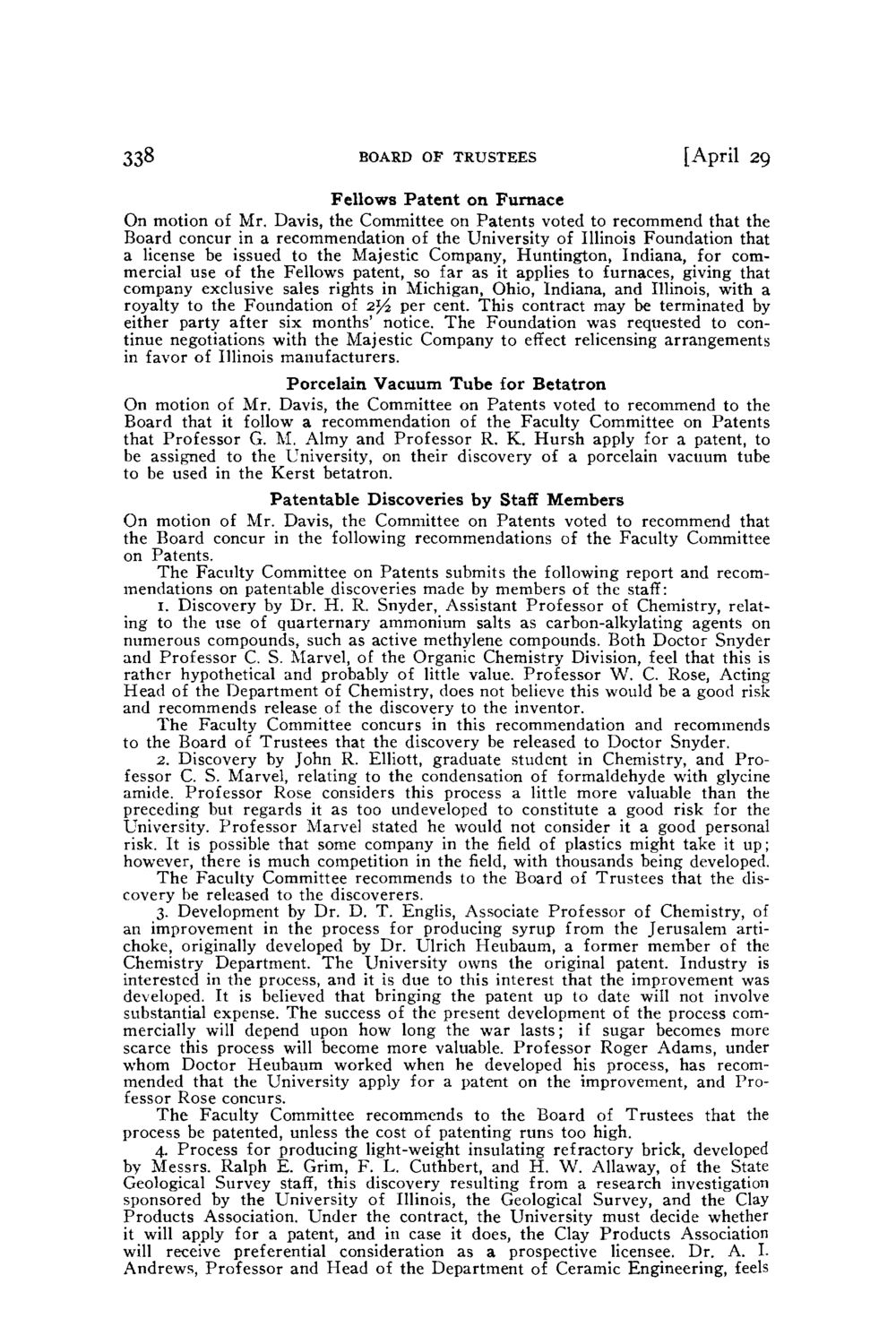| |
| |
Caption: Board of Trustees Minutes - 1944
This is a reduced-resolution page image for fast online browsing.

EXTRACTED TEXT FROM PAGE:
338 BOARD OF TRUSTEES [April 29 F e l l o w s Patent o n Furnace On motion of Mr. Davis, the Committee on Patents voted to recommend that the Board concur in a recommendation of the University of Illinois Foundation that a license be issued to the Majestic Company, Huntington, Indiana, for commercial use of the Fellows patent, so far as it applies to furnaces, giving that company exclusive sales rights in Michigan, Ohio, Indiana, and Illinois, with a royalty to the Foundation of 2^4 per cent. This contract may be terminated by either party after six months' notice. T h e Foundation was requested to continue negotiations with the Majestic Company to effect relicensing arrangements in favor of Illinois manufacturers. Porcelain Vacuum Tube for Betatron On motion of Mr. Davis, the Committee on Patents voted to recommend to the Board that it follow a recommendation of the Faculty Committee on Patents that Professor G. M. Almy and Professor R. K. H u r s h apply for a patent, to be assigned to the University, on their discovery of a porcelain vacuum tube to be used in the Kerst betatron. Patentable Discoveries by Staff Members On motion of Mr. Davis, the Committee on Patents voted to recommend that the Board concur in the following recommendations of the Faculty Committee on Patents. T h e Faculty Committee on Patents submits the following report and recommendations on patentable discoveries made by members of the staff: 1. Discovery by Dr. H . R. Snyder, Assistant Professor of Chemistry, relating to the use of quarternary ammonium salts as carbon-alkylating agents on numerous compounds, such as active methylene compounds. Both Doctor Snyder and Professor C. S. Marvel, of the Organic Chemistry Division, feel that this is rather hypothetical and probably of little value. Professor W . C. Rose, Acting Head of the Department of Chemistry, does not believe this would be a good risk and recommends release of the discovery to the inventor. The Faculty Committee concurs in this recommendation and recommends to the Board of Trustees that the discovery be released to Doctor Snyder. 2. Discovery by John R. Elliott, graduate student in Chemistry, and P r o fessor C. S. Marvel, relating to the condensation of formaldehyde with glycine amide. Professor Rose considers this process a little more valuable than the preceding but regards it as too undeveloped to constitute a good risk for the University. Professor Marvel stated he would not consider it a good personal risk. It is possible that some company in the field of plastics might take it u p ; however, there is much competition in the field, with thousands being developed. T h e Faculty Committee recommends to the Board of Trustees that the discovery be released to the discoverers. 3. Development by Dr. D. T. Englis, Associate Professor of Chemistry, of an improvement in the process for producing syrup from the Jerusalem artichoke, originally developed by Dr. Ulrich Heubaum, a former member of the Chemistry Department. T h e University owns the original patent. Industry is interested in the process, and it is due to this interest that the improvement was developed. It is believed that bringing the patent up to date will not involve substantial expense. The success of the present development of the process commercially will depend upon how long the war lasts; if sugar becomes more scarce this process will become more valuable. Professor Roger Adams, under whom Doctor Heubaum worked when he developed his process, has recommended that the University apply for a patent on the improvement, and Professor Rose concurs. T h e Faculty Committee recommends to the Board of Trustees that the process be patented, unless the cost of patenting runs too high. 4. Process for producing light-weight insulating refractory brick, developed by Messrs. Ralph E. Grim, F . L. Cuthbert, and H . W. Allaway, of the State Geological Survey staff, this discovery resulting from a research investigation sponsored by the University of Illinois, the Geological Survey, and the Clay Products Association. Under the contract, the University must decide whether it will apply for a patent, and in case it does, the Clay Products Association will receive preferential consideration as a prospective licensee. Dr. A. I. Andrews, Professor and Head of the Department of Ceramic Engineering, feels
| |